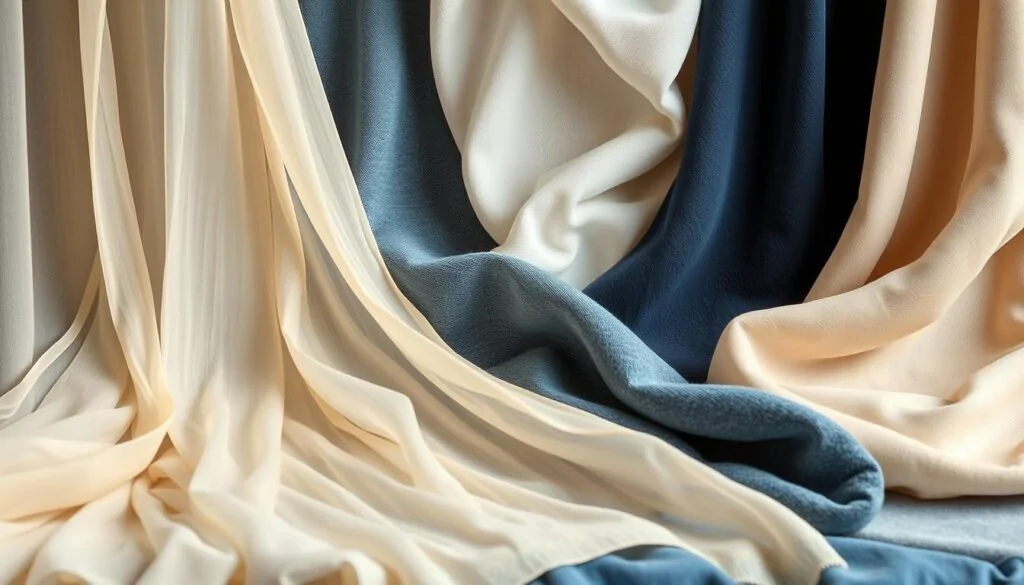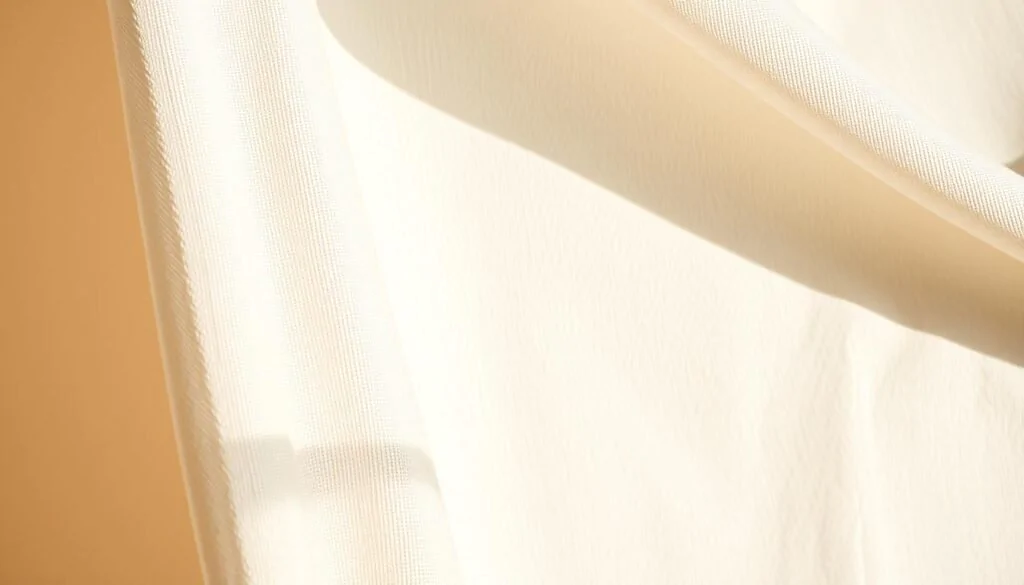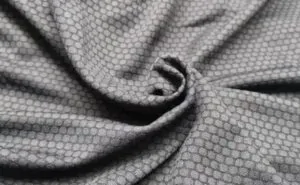What makes a fabric right for a project? Is it the fabric type, weight, or something else? Knowing about fabric weight is key in choosing the right fabric. It affects the quality, durability, and how well the product works.
There are many ways to measure fabric weight, like grams per square meter (GSM) and ounces per square yard (oz/yd²). It can be hard to understand all these measurements.
Experts say knowing about fabric weight is vital for making top-quality products. There are many fabric weights, from 50 GSM to 689 GSM. This shows how important fabric weight is in the garment industry.
But how does this help you? How can you choose the right fabric weight and type for your needs?
We will look into fabric weight, including how to measure it and its impact on making clothes. Whether you design clothes, make textiles, or just like sewing, knowing about fabric weight is crucial. It helps you make products that your customers will love. So, let’s start exploring fabric weight and textile selection together.
Understanding Fabric Weight Fundamentals
Fabric weight is measured in grams per square meter (GSM) or ounces per square yard (oz/yd²). This is key to picking the right fabric for your project. Lighter fabrics are great for soft, flowing items. Heavier fabrics are best for durable pieces like pants and coats.
The weight of the fabric greatly affects the product’s durability and feel. This, in turn, impacts customer satisfaction and your brand. Ultra-light fabrics are under 100 GSM, while midweight ones are between 170 and 340 GSM. Heavyweight fabrics start at 340 GSM. Knowing this helps you make better choices for your garments.

- Ultra Light: under 100 GSM
- Lightweight: 100-170 GSM
- Midweight: 170-340 GSM
- Heavyweight: 340-400 GSM
- Ultra Heavy: over 400 GSM
Understanding these basics helps you pick the perfect fabric for your projects. This way, you can create high-quality items that your customers will love.
The Science Behind Textile Weight Categories
Textile weight categories, fabric types, and weight classes are complex. Working with various fabrics, I’ve learned the importance of understanding these categories. Each fabric has its own unique properties, like breathability and insulation, which depend on its weight.
Medium-weight fabrics (200-400 GSM) make up about 60% of the world’s clothing. They’re loved for being both durable and comfortable. In contrast, heavy-weight fabrics (above 400 GSM) are used for outerwear and home textiles. They’re chosen for their durability and ability to keep warm.
Here are some key factors to consider when it comes to textile weight categories:
- Fabric type: Different fabrics have unique properties and characteristics that affect their weight and performance.
- Weight class: The weight class of a fabric can impact its durability, comfort, and insulation.
- End-use: The intended use of the fabric can influence the choice of textile weight category.

Understanding the science behind textile weight categories helps us make better choices. Whether you’re in the textile industry, fashion design, or sewing, this knowledge is crucial. It allows you to create high-quality products that meet your customers’ needs.
Essential Tools for Measuring Fabric Weight
Measuring fabric weight accurately is key. I’ve worked with fabrics and know the importance of the right tools. Here, I’ll talk about the must-haves for measuring fabric weight. This includes digital scales, traditional methods, and professional gear.
To get precise fabric weight measurement, you need the right tools. Here are some:
- Digital fabric scales: They’re handy and give quick, accurate readings.
- Traditional measurement methods: Use a ruler and calculator for precise weight.
- Professional testing equipment: Special machines for super accurate weight checks.
Also, don’t forget about traditional methods
With the right tools and methods, you can measure fabric weight accurately. This helps you make smart choices when picking fabrics. Whether you prefer digital scales or traditional methods, pick what suits you best.
Industry Standards for Fabric Weight
Exploring the world of textile production shows me how key industry standards for fabric weight are. These standards help keep fabric production consistent and accurate. This is important for everyone involved in textiles, from manufacturers to designers and hobbyists.
Fabric weight is usually measured in grams per square meter (GSM) or ounces per square yard (oz/yd²). There are specific weight classes for fabrics, like light, medium, and heavy. For example, light fabrics are between 30 to 150 GSM. Medium weight fabrics are 150 to 350 GSM, and heavy ones start at 350 GSM, like clear window PVC at 640 GSM.
Some important things to know about fabric weight standards include: * The weight of fabric impacts its durability and how well it performs. * Different fields, like upholstery and clothing, have their own weight standards. * Knowing these standards helps manufacturers and designers choose the right fabrics.
By grasping these standards, textile makers and designers can create high-quality products. This is true for clothes, furniture, or other items. Industry standards are key to ensuring fabric weight is consistent and accurate, which is vital for the textile industry.
How Fabric Weight Affects Drape and Performance
When it comes to fabric, weight is key. It affects how the fabric drapes and performs. Heavier fabrics usually drape more structured, while lighter ones are flowier. But, other things like fiber and weave also matter.
Heavier fabrics last longer and are more durable. They’re great for things that need to last. Lighter fabrics might pill or snag but feel softer. The right fabric weight depends on what you need, like performance or comfort.
When picking a fabric weight, think about: * How it drapes and moves * Its durability * How it feels on your skin Choosing wisely lets you get the fabric you need for your project.
Seasonal Considerations in Fabric Weight Selection
Choosing the right fabric weight is key, and seasonal considerations are important. Different weights fit different seasons and climates. For example, light fabrics are great for summer, and heavy ones are better for winter.
Fabric weight is measured in grams per square meter (GSM). It ranges from very light (under 100 GSM) to very heavy (over 400 GSM). The best textile selection depends on how you plan to use the fabric, the season, and the climate.
Here are some tips for picking fabric weight based on the season:
- Summer: lightweight fabrics (100-170 GSM) for breathable and cool clothing
- Winter: heavyweight fabrics (340-400 GSM) for warm and durable clothing
- Spring and Autumn: midweight fabrics (170-340 GSM) for versatile and comfortable clothing
By thinking about seasonal considerations and picking the right fabric weight, you can make high-quality products. Whether it’s clothing, upholstery, or other textiles, the right textile selection is crucial for success.
Common Challenges in Working with Different Fabric Weights

Working with fabrics can be tricky. Knowing the challenges of different weights is key to making great products. Each weight, from light to heavy, comes with its own set of problems.
Light-weight fabrics often feel see-through and lack structure. Medium-weight fabrics are versatile but not as durable as heavy ones. Heavy-weight fabrics are sturdy but hard to drape and breathe.
Light-weight fabrics are hard to sew and tend to lose their shape. Medium-weight fabrics are easier but can shrink and lack texture. Heavy-weight fabrics are tough to cut and sew, needing special tools.
To beat these challenges, it’s vital to know each fabric’s traits. Choose the right fabric for your project. This way, your product will meet quality and performance standards.
Professional Tips for Choosing the Right Fabric Weight
Starting out with textiles, I found picking the right fabric weight is key for quality products. Textile experts say the right weight can affect a garment’s durability and performance. When picking, think about the fabric’s use, the season, and how comfortable and durable you want it to be.
Experts recommend starting with midweight fabrics, between 170 to 340 GSM, for beginners. These are versatile for many garments, like tops, dresses, pants, and jackets. But, remember to match the fabric weight to your project’s needs. For example, a summer dress might need a lighter fabric, around 100-170 GSM.
When choosing a fabric weight, consider a few things:
- Durability: Heavier fabrics last longer and wrinkle less. Lighter ones are more delicate and need more care.
- Comfort: Lighter fabrics feel softer against your skin. Heavier ones offer more structure and support.
- Season: Use lightweight fabrics for summer clothes and heavier ones for winter.
By thinking about these points and getting advice from experts, you can pick the right fabric weight. This will help you make high-quality products that your customers will love. I’ve learned that the right fabric weight can really make a difference. With the right tips, you can become great at choosing fabric weights.
International Fabric Weight Standards and Conversions
Understanding fabric weight standards is key when working with fabrics. It ensures consistency and accuracy in textile production. European standards are widely used, making them crucial for international trade.
Fabrics are measured in grams per square meter (GSM) or ounces per square yard (oz/yd²). Knowing these measurement systems and conversion formulas is essential. For example, 150 GSM is about 4.4 oz/yd².
Understanding European Standards
European standards use the GSM system to measure fabric weight. This system is a quality benchmark in the European textile industry.
Asian Markets and American Metrics
In Asia, fabric weight is measured in ounces per square yard (oz/yd²). In the U.S., both GSM and oz/yd² are used. Knowing these systems and formulas is vital for international trade and textile quality.
The Future of Smart Textiles and Weight Innovation
Exploring smart textiles, I’m excited about the future trends. These trends include sensors, conductive materials, and new ways to make fabrics. Smart textiles could change how we use fabrics, from health monitoring to sensing the environment.
Key trends include conductive fibers, shape-memory materials, and nanotechnology. These advancements let fabrics react to things like temperature and light. For example, researchers at Washington State University made a fiber that’s both flexible and electrically conductive. It’s for detecting hazards and monitoring health.
Smart textiles are also about making fabrics lighter and more comfortable. This is good for wearable technology, athletic apparel, and medical textiles. As the field grows, we’ll see even more advanced materials and technologies.
In conclusion, the future of smart textiles and weight innovation is very promising. With ongoing research and innovation, we’ll see new materials that change our lives and how we interact with the world.
Conclusion
Mastering fabric weight is key to making top-notch textile products. Knowing the basics, industry standards, and how to apply them helps designers and makers. This guide has shown you how to pick the right fabric for your products.
For summer t-shirts, the GSM range of 120-160 g/m² is perfect. For high-quality sweatshirts, you’ll want GSM of 300-400 g/m². This knowledge lets you meet your customers’ needs.
Embracing smart textiles and weight innovations keeps you ahead. The right fabric weight affects a garment’s look, feel, and how well it lasts. Use what you’ve learned to improve your textile selection skills.
This will open up new possibilities in fashion and textile design. You’ll create products that impress your customers.







